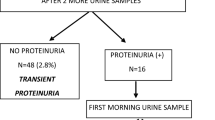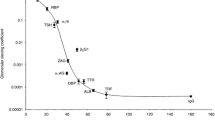Abstract
Proteinuria detection in children is a challenge. Five percent to 15% and 0.4–1% of school children present either transient (benign) or persistent increased amount of protein in urine, respectively. Persistent proteinuria constitutes not only a sign of overt kidney disease but may also be the first indicator of silent renal damage. Proteinuria is a marker for hyperfiltration in individuals with reduced nephron mass and one of the most important independent risk factor for renal disease progression as well. It constitutes the single most important risk factor for future loss of kidney function, preceding glomerular filtration rate reduction. Further, proteinuria itself is diagnostic of cardiovascular disease with prognostic value and target organ involvement in high-risk populations such as diabetic, obese, hypertensive children, or those with known reduced renal mass or previous renal injury. Current strategies to prevent CKD progression, a concept known as renoprotection, are focused on reducing urinary protein excretion among other factors. Reversibility of organ damage in early stages is possible; therefore, pediatricians should screen children for proteinuria or microalbuminuria, mainly in high-risk groups.

Similar content being viewed by others
References
Abitbol CL, Chandar J, Onder AM et al (2006) Profiling proteinuria in pediatric patients. Pediatr Nephrol 21:995–1002
Ardissino G, Dacco V, Testa S et al (2003) Epidemiology of chronic renal failure in children: data from the ItalKid Project. Pediatrics 111:382–287
Brandt JR, Jacobs A, Raissy HH et al (2010) Orthostatic proteinuria and the spectrum of diurnal variability of urinary protein in healthy children. Pediatr Nephrol 25:1131–1137
Chadban SJ, Atkins RC (2005) Glomerulonephritis. Lancet 365:1797–1806
Cho HY, Lee BH, Choi HJ et al (2008) Renal manifestations of Dent disease and Lowe syndrome. Pediatr Nephrol 23:243–249
Copelovitch L, Nash MA, Kaplan BS (2007) Hypothesis: Dent disease is an underrecognized cause of focal glomerulosclerosis. Clin J Am Soc Nephrol 2:914–918
Dent CE, Friedman M (1964) Hypercalciuric rickets associated with renal tubular damage. Arch Dis Child 39:240–249
Eddy AA, Symonds JM (2003) Nephrotic syndrome in childhood. Lancet 23:629–639
Edström Halling S (2010) Predictors of outcome in Henoch-Schönlein nephritis. Pediatr Nephrol 25(6):1101–1108
Frymoyer PA, Scheinman SJ, Dunham PB et al (1991) X-linked recessive nephrolithiasis with renal failure. N Engl J Med 325:681–686
Glassock RJ (2005) Hematuria and proteinuria. In: Greenberg A, Cheung AK, Coffman TM, Falk RJ, Jennette JC (eds) Primer on kidney disease: National Kidney Foundation, 4th edn. Saunders, Philadelphia, pp 36–46
Gorman D, Sochett E, Daneman D (1999) The natural history of microalbuminuria in adolescents with type I diabetes. J Pediatr 134:333–337
Haraldsson B, Nystrom J, Deen WM (2008) Properties of the glomerular barrier and mechanisms of proteinuria. Physiol Rev 88:451–487
Hogg R (2009) Screening for CKD in children: a global controversy. Clin J Am Soc Nephrol 4:509–515
Hogg RJ, Portman RJ, Milliner D et al (2000) Evaluation and management of proteinuria and nephrotic syndrome in children: recommendations from a pediatric nephrology panel established at the National Kidney Foundation Conference on proteinuria, albuminuria, risk, assessment, detection, and elimination (PARADE). Pediatrics 105:1242–1249
Hoopes RR Jr, Shrimpton AE, Knohl SJ et al (2005) Dent disease with mutations in OCRL1. Am J Hum Genet 76:260–267
Houser MT (1984) Assessment of proteinuria using random urine samples. J Pediatr 104:845–848
Jensen JS, Feldt-Rasmussen B, Strandgaard S et al (2000) Arterial hypertension, microalbuminuria and risk of ischemic heart disease. Hypertension 35:898–903
Litwin M, Grenda R, Sladowska J, Antoniewicz J (2006) Add-on therapy with angiotensin II receptor 1 blocker in children with chronic kidney disease already treated with angiotensin-converting enzyme inhibitors. Pediatr Nephrol 21:1716–1722
Locatelli F, Marcelli D, Comelli M et al (1996) Proteinuria and blood pressure as causal components of progression to end-stage-kidney failure. Northern Italian Cooperative Study Group. NDT 11:461–467
Loi M (2006) Lowe syndrome. Orphanet J Rare Dis 1:16
Norden AGW, Scheinman SJ, Deschodt-Lanckman MM et al (2000) Tubular proteinuria defined by a study of Dent’s (CLCN5 mutation) and other tubular diseases. Kidney Int 57:240–249
Quigley R (2008) Evaluation of hematuria and proteinuria: how should a pediatrician proceed? Curr Opin Pediatr 20:140–144
Rademacher ER, Sinaiko AR (2009) Albuminuria in children. Curr Opin Nephrol Hypertens 18:246–251
Ramaswami U, Najafian B, Schieppati A et al (2010) Assesment of renal pathology and dysfunction in children with Fabry Disease. Clin J Am Soc Nephrol 5:365–370
Ritz E (1999) Nephropathy in patients with type 2 diabetes mellitus. N Eng J Med 341:1127–1133
Reichel H, Zeier M, Ritz E (2004) Proteinuria after renal transplantation: pathogenesis and management. NDT 19:301–305
Salgado CM, Jardim PC, Teles FB, Nunes MC (2009) Influence of low birth weight on microalbuminuria and blood pressure of school children. Clin Nephrol 71(4):367–374
Savino A, Pelliccia P, Chiarelli F, Mohn A (2010) Obesity-related renal injury in childhood (2010). Horm Res Paediatr 73:303–311
Seeman T, Dusek J, Vondrak K et al (2009) Profiling proteinuria in children after renal transplantation. Pediatr Nephrol 24:2439–2444
TØndel C, Bostad L, Hirth A, Svarstad E (2008) Renal biopsy findings in children and adolescents with Fabry Disease and minimal albuminuria. Am J Kidney Dis 51:767–776
Tomlinson PA, Dalton RN, Turner C, Chantler C (1990). Measurement of beta 2-microglobulin, retinol-binding protein, alpha 1-microglobulin and urine protein 1 in healthy children using enzyme-linked immunosorbent assay. Clin Chem Acta 192(2):99–106
Yap HK, Lau YW (2008) Hematuria and proteinuria. In: Geary DF, Schaefer F (eds) Comprehensive pediatric nephrology. Elsevier, Philadelphia, pp 179–193
Van Dyck M, Proesmans W (2004) Renoprotection by ACE inhibitors after severe hemolytic uremic syndrome. Pediatr Nephrol 19:688–690
Viberti GC, Hill RD, Jarrett RJ et al (1982) Microalbuminuria as a predictor of clinical nephropathy in insulin-dependent diabetes mellitus. Lancet 1:1430–1432
Wühl E, Schaefer F (2008) Therapeutic strategies to slow chronic disease progression. Pediatr Nephrol 23:705–716
Wühl E, Trivelli A, Picca S, The escape trial group et al (2009) Strict blood-pressure control and progression of renal failure in children. N Engl J Med 361:1639–1650
Author information
Authors and Affiliations
Corresponding author
Rights and permissions
About this article
Cite this article
Ariceta, G. Clinical practice. Eur J Pediatr 170, 15–20 (2011). https://doi.org/10.1007/s00431-010-1334-0
Received:
Accepted:
Published:
Issue Date:
DOI: https://doi.org/10.1007/s00431-010-1334-0




